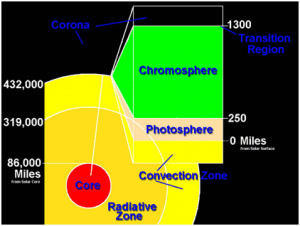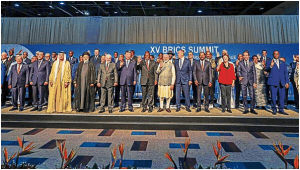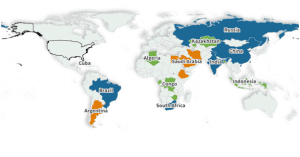1. PRADHAN MANTRI JAN DHAN YOJANA (PMJDY) COMPLETES NINE YEARS
TAG: GS 3: ECONOMY
THE CONTEXT: The Pradhan Mantri Jan Dhan Yojana (PMJDY), launched to enable financial inclusion, completes nine years on 28 August 2023.
EXPLANATION:
- The total number of PMJDY accounts stood at 500 million, up from 147.2 million at the end of March 2015. At the end of March 2023, the total number of PMJDY accounts stood at 486.5 million.
- Meanwhile, total deposits in these accounts combined stood at a ₹03 trillion on 16 August, up from ₹15,670 crores at the end of March 2015.
- Similarly, the number of Rupay debit cards issued for PMJDY accounts increased to 339.8 million as of 16 August, from 131.5 million at the end of March 2015.
- The PMJDY scheme is responsible for providing basic banking facilities to the underprivileged, catalysing the government’s mission for financial inclusion.
- According to data from the Ministry of Finance, of the total Jan Dhan accounts, 56% belong to women and 67% accounts have been opened in rural/semi-urban areas.
- The PMJDY scheme has been successful in changing the financial landscape of the country and has brought near saturation in bank accounts for adults.
- The success of PMJDY lies in the comprehensive nature of the scheme with an attempt to connect the last mile with the formal banking system through technology, collaboration and innovation.
- Meanwhile, a total of 6.01 lakh villages have been mapped on the Jan Dhan Darshak mobile application, which provides citizen centric platform for locating banking touch points like bank branches, ATMs, etc.
JAN DHAN YOJANA
- The Scheme was announced on 15 August 2014 to provide universal access to banking services. The scheme was launched on 28 August 2014.
- The National Mission of Financial Inclusion named as the Pradhan Mantri Jan Dhan Yojana seeks to integrate the poorest of the poor with bank accounts.
- Pradhan Mantri Jan Dhan Yojana (PMJDY) is the National Mission for Financial Inclusion.
- It ensures access to financial services, namely, Banking/ Savings & Deposit Accounts, Remittance, Credit, Insurance, Pension in an affordable manner.
- The scheme offers multiple advantages to account holders such as a bank account without requirement of minimum balance, free of cost RuPay debit cards with inbuilt accident insurance of ₹2 lakh and overdraft facility of up to ₹10,000.
Salient features of the scheme
- All households across the countryboth rural and urban are to be covered under the scheme. Bank accounts will be opened for 15 crore poor persons. The current focus is on opening accounts from “every household to every adult”.
- PMJDY accounts are being opened with zero balance.
- All bank accounts opened under the scheme are to have an overdraft (OD) facility of Rs 10,000 for Aadhar-linked accounts after satisfactory operation in the account for 6 months. There will not be any conditions attached for OD upto Rs 2,000. Age limit for availing OD facility is 18-65 years.
- Issuance of RuPay Debit Card with inbuilt Rs 2 lakh personal accident insurance cover. The increased coverage amount of Rs. 2 lakh is for PMJDY accounts opened after 28.08.2018.
- A minimum monthly remuneration of Rs 5,000 to business correspondents who will provide the last link between the account holders and the bank.
- PMJDY accounts are eligible for Direct Benefit Transfer (DBT), Pradhan Mantri Jeevan Jyoti Bima Yojana (PMJJBY), Pradhan Mantri Suraksha Bima Yojana (PMSBY), Atal Pension Yojana (APY), Micro Units Development & Refinance Agency Bank (MUDRA) scheme.
Jan Dhan Darshak App (JDD App)
- JDD App is a mobile application which provides a citizen centric platform for locating banking touch points such as bank branches, ATMs, Banking Correspondents (BCs), Indian Post Payment Banks etc. in the country.
- Over 13 lakh banking touchpoints have been mapped on the JDD App. The facilities under Jan Dhan Darshak App could be availed as per the need and convenience of common people.
- This app is also being used for identification of villages which are yet to covered by banking outlets within 5 km radius.
- These identified villages are allocated to various banks by concerned SLBCs for opening of banking outlets. The efforts have resulted in a significant decrease in number of uncovered villages.
SOURCE: https://pib.gov.in/PressReleaseIframePage.aspx?PRID=1952793
2. P75 (I) PROGRAMME
TAG: GS 3: SECURITY; SCIENCE AND TECHNOLOGY
THE CONTEXT: A combination of structural inefficiencies, budgetary changes, tendering problems, delays, and institutional ad-hocism have hindered India’s submarine manufacturing ambitions. India must ensure adequate institutional thrust on overcoming impediments and moving ahead with the P75(I) programme for submarine manufacture.
EXPLANATION:
- The original P75 proposed the domestic construction of six Scorpène-class conventional diesel-electric submarines by Mazagaon Docks Limited through a transfer of technology collaboration with France’s Naval Group.
- The project was supposed to be completed by 2017. However, far from completion, the lead boat of the P75 project, INS Kalvari, was only commissioned in 2017.
- Only recently has the country commissioned the fifth submarine out of the proposed six submarines; the final one is expected next year.
- The more recent P75(I) programme budgeted at approximately Rs 40,000 crore to build six conventional submarines with state-of-the-art sensors and weapons and, with an air-independent propulsion system (AIP) is also lagging behind schedule.
- It is now essential for India to reinvigorate the P75(I) programme and capitalise on the reported bids.
- The Navy and the ministry of defence must sort out impractical delivery schedules, stringent technology transfer requirements, detrimental liability clauses, restrictive contractual practices, and penalties that have impeded the programme.
What is Project-75 (I)?
- Project-75 (India) or P-75(I), is a military acquisition initiative by the Ministry of Defence (MoD).
- The initiative aims to procure diesel-electric attack submarines with fuel cells and Air-Independent Propulsion System (AIP) for the Indian Navy to build India’s naval strength and develop indigenous submarine-building capabilities.
Difference between Project 75 and Project 75I
- Project 75I is a follow-up to Project 75 and improves upon the design and technology of its predecessor.
- The conventional diesel-electric submarines such as the Scorpene, under Project 75, come with improved stealth features such as advanced acoustic absorption techniques, low radiated noise levels, long-range guided torpedoes, tube-launched anti-ship missiles, sonars and sensor suites.
- The AIP technology will improve on this in Project 75I building six submarines that can stay submerged for up to two weeks. These submarines may even be larger in size compared to the ones under Project 75.
What is Project 75?
- Project-75 was conceived in 1997 for the construction of two indigenous Submarines known as Type 1500.
- The project was approved by the Cabinet Committee on Security (CCS), the decision-making body of the Ministry of Defence (MoD).
- Mazagon Dock Shipbuilders Limited (MDL), which comes under MoD, was contracted to build the submarines in collaboration with Thomson-CSF (TCSF), France, at an estimated cost of Rs. 700 crore.
- Project 75 was aimed at building six conventional Scorpene-class attack submarines.
- 6 Submarine Names List in Project 75
- The first submarine under Project 75 was INS Kalvari. It was delivered in 2015 and joined the service in December 2017.
- Within only two years, in September 2019, INS Khanderi, the 2nd submarine under Project 75, was deployed.
- The third submarine, INS Karanj, was inducted in March 2021.
- INS Vela, the fourth submarine under Project 75, joined the fleet in November 2021.
- The fifth submarine, INS Vagir, commenced in November 2020 and is anticipated to be appointed by the latter quarter of 2022.
- The sixth submarine completed under the project is INS Vagsheer. It is a reincarnation of the first Vagsheer, withdrawn from service in April 1997. The vessel is titled after the name of a fatal deep sea hunter in the Indian Ocean and was launched in April 2022.
Five of these submarines have now been built, with the last one, INS Vaghsheer, being readied to commence sea trials. It will likely be inducted into the Navy by the end of this year.
3. THE UN COMMISSION ON INTERNATIONAL TRADE LAW (UNCITRAL)
TAG: GS 2: INTERNATIONAL RELATIONS
THE CONTEXT: India and Iran drop foreign arbitration clause in Chabahar port issue. Both sides have agreed to pursue arbitration under rules framed by the UN Commission on International Trade Law (UNCITRAL) which is favoured by India over other international trade arbitration mechanisms.
EXPLANATION:
- In a move aimed at boosting India-Iran commercial relations, Tehran and New Delhi have agreed to drop the clause for arbitration in foreign courts concerning the Chabahar port.
- The new move to pursue arbitration under rules framed by the UN Commission on International Trade Law will help firm up longer-term agreement and boost investor confidence in Chabahar.
- According to the Ministry of External Affairs, Both countries reiterated their commitment to further strengthen bilateral cooperation including to realise the full potential of Chabahar Port as a connectivity hub.
- A longer-term term agreement between India and Iran over Chabahar will ensure greater predictability and boost the confidence of stakeholders in the feasibility of the facility which is located in southeastern coast of Iran.
UN Commission on International Trade Law (UNCITRAL)
- The term United Nations Commission on International Trade Law (UNCITRAL) established in 1966, refers to a subsidiary body of the United Nations General Assembly.
- It is the core legal body of the U.N,’s system in the field of international trade law. The official function of UNCITRAL is to modernize and harmonize the rules of international business.
- UNCITRAL is headquartered in New York, which is the same location as the U.N.’s headquarters. Annual sessions take place once each year usually in the summer and are held alternatively in New York and at the Vienna International Centre in Vienna.
- UNCITRAL aims to formulate modern, fair, and harmonized rules for such commercial transactions. The organization is responsible for helping to facilitate international trade and investment.
- Its work includes conventions, model laws, and rules which are acceptable worldwide; legal and legislative guides, and practical recommendations; updated information on case law and enactments of uniform commercial law; technical assistance in law reform projects; and regional and national seminars on uniform commercial law.
- Membership of UNCITRAL is determined by the U.N. General Assembly. The original membership comprised 29 member states of the U.N. But this number was expanded to 36 in 1973. Its membership grew again in 2002 to 60 states, and again in 2022 with a total of 70 member states.
- Member states are deliberately chosen to be globally representative. The organization aims to include 14 African states, 14 Asian states, eight Eastern European states, 10 Latin American and Caribbean states, 14 Western European states, and others.
- It was established in response to the rapid rise of global trade that took place in the 1960s. At the time, national governments recognized the need for harmonized global standards to replace the various national and regional regulations.
- The organization is also responsible for coordinating the work of other bodies active in international trade, both within and outside of the UN, to enhance cooperation, consistency, and efficiency while avoiding duplication.
Its mandate covers include:
- Dispute resolution
- International contract practices
- Transport
- Insolvency
- Electronic commerce
- International payments
- Secured transactions
- Procurement
- The sale of goods
CHABAHAR PORT
- Chabahar Port is India’s first foreign port project and is considered a gateway to golden opportunities for trade by India, Iran and Afghanistan with Central Asian countries.
- The Chabahar port actually contains two separate ports called Shahid Kalantari and Shahid Beheshti.
- It is located in South eastern Iran in the southeastern province of Sistan-Baluchestan in the Gulf of Oman. It is the only Iranian port with direct access to the ocean.
- The idea is that the port would enable India to bypass Pakistan and access Afghanistan, and ultimately Central Asia.
- Moreover, the port could serve as a hub for transit trade between India, Iran, and Afghanistan, and provide an alternative route to the traditional Silk Road that passes through China.
- With its strategic location near the Strait of Hormuz and the Indian Ocean, the port offers significant potential.

4. ADITYA L1 MISSION
TAG: GS 3: SCIENCE AND TECHNOLOGY
THE CONTEXT: The Indian Space & Research Organization (ISRO) is all set to launch the Aditya L1 on 2nd September 2023 after the successful landing of Chandrayaan 3.
WHAT IS ADITYA L1 MISSION?
- Aditya L1 shall be the first space based Indian mission to study the Sun.
- The spacecraft shall be placed in a halo orbit around the Lagrange point 1 (L1) of the Sun-Earth system, which is about 1.5 million km from the Earth.
- A satellite placed in the halo orbit around the L1 point has the major advantage of continuously viewing the Sun without any occultation/eclipses.
- This will provide a greater advantage of observing the solar activities and its effect on space weather in real time.
- The spacecraft carries seven payloads to observe the photosphere, chromosphere, and the outermost layers of the Sun (the corona) using electromagnetic and particle and magnetic field detectors.
- Using the special vantage point L1, four payloads directly view the Sun, and the remaining three payloads carry out in-situ studies of particles and fields at the Lagrange point L1.
- It will provide important scientific studies of the propagatory effect of solar dynamics in the interplanetary medium.

Layers of the sun
WHAT ARE THE OBJECTIVES OF ADITYA-L1 MISSION?
The major objectives of Aditya-L1 mission are:
- Study of Solar upper atmospheric (chromosphere and corona) dynamics.
- Study of chromospheric and coronal heating, physics of the partially ionized plasma, initiation of the coronal mass ejections, and flares.
- Observe the in-situ particle and plasma environment providing data for the study of particle dynamics from the Sun.
- Physics of solar corona and its heating mechanism.
- Diagnostics of the coronal and coronal loops plasma’s temperature, velocity, and density.
- Development, dynamics, and origin of Coronal Mass Ejections (CMEs).
- Identify the sequence of processes that occur at multiple layers (chromosphere, base, and extended corona) which eventually leads to solar eruptive events.
- Magnetic field topology and magnetic field measurements in the solar corona.
- Drivers for space weather (origin, composition, and dynamics of solar wind.
ADITYA-L1 PAYLOADS:

- The instruments of Aditya-L1 are tuned to observe the solar atmosphere mainly the chromosphere and corona.
- In-situ instruments will observe the local environment at L1.
- There are total seven payloads on-board with four of them carrying out remote sensing of the Sun and three of them carrying in-situ observation.
|
Type |
Sl. No. | Payload | Capability |
| Remote Sensing Payloads | 1 | Visible Emission Line Coronagraph (VELC) | Corona/Imaging & Spectroscopy |
| 2 | Solar Ultraviolet Imaging Telescope (SUIT) | Photosphere and Chromosphere Imaging- Narrow & Broadband | |
| 3 | Solar Low Energy X-ray Spectrometer (SoLEXS) | Soft X-ray spectrometer: Sun-as-a-star observation | |
| 4 | High Energy L1 Orbiting X-ray Spectrometer (HEL1OS) | Hard X-ray spectrometer: Sun-as-a-star observation | |
| In-situ Payloads | |||
| 5 | Aditya Solar wind Particle Experiment (ASPEX) | Solar wind/Particle Analyzer Protons & Heavier Ions with directions | |
| 6 | Plasma Analyser Package for Aditya (PAPA) | Solar wind/Particle Analyzer Electrons & Heavier Ions with directions | |
| 7 | Advanced Tri-axial High Resolution Digital Magnetometers | In-situ magnetic field (Bx, By and Bz). |
5. XV BRICS SUMMIT
TAG: GS 2: INTERNATIONAL RELATIONS
THE CONTEXT: Argentina, Egypt, Ethiopia, Iran, Saudi Arabia, and the United Arab Emirates have been invited to become full members of BRICS from 1 January 2024.
EXPLANATION:
- The 15th BRICS Summit was held in Johannesburg, South Africa, from 22-24 August 2023.
- Its theme was “BRICS and Africa: Partnership for Mutually Accelerated Growth, Sustainable Development and Inclusive Multilateralism”.
- Terrorism, multilateral reform, digital economy, trade and food security issues were discussed during the summit.

EXPANSION OF BRICS:
- In a landmark decision, members of the BRICS (Brazil, Russia, India, China and South Africa) in August 2023 declared expansion of the grouping by welcoming six new countries into the fold.
- Argentina, Egypt, Ethiopia, Iran, Saudi Arabia, and the United Arab Emirates have been invited to become full members of BRICS from 1 January 2024.
- BRICS would be able to have new dynamism and energy in its actions.
- Addition of Iran, Saudi Arabia and the UAE is of special significance as the three will represent both flanks of the energy-rich Gulf in the BRICS.
- Joining the BRICS is also the first time that Iran and Saudi Arabia took a common diplomatic decision months after they normalised relation in April 2023.
BRICS Nations and prospective countries
Blue colour represent members.
Orange colour represent new members.
Green colour represent Prospective members.

BRICS:
- The term “BRIC” was coined by the British Economist Jim O’Neill in 2001 to describe the four emerging economies of Brazil, Russia, India, and China.
- The leaders of BRIC (Brazil, Russia, India, and China) countries met for the first time in St. Petersburg, Russia, on the margins of G8 Outreach Summit in July 2006.
- In September 2006, the group was formalised as BRIC during the 1st BRIC Foreign Ministers’ Meeting, which met on the sidelines of the General Debate of the UN Assembly in New York City.
- After a series of high-level meetings, the 1st BRIC summit was held in Yekaterinburg, Russia on 16 June 2009.
- BRIC group was renamed as BRICS (Brazil, Russia, India, China, South Africa) after South Africa was accepted as a full member at the BRIC Foreign Ministers’ meeting in New York in September 2010.
- South Africa attended the 3rd BRICS Summit in Sanya, China on 14 April 2011.
- BRICS is an important grouping bringing together the major emerging economies from the world, comprising 41% of the world population, having 24% of the world GDP and over 16% share in the world trade.
- BRICS countries have been the main engines of global economic growth over the years.
- Over a period, BRICS countries have come together to deliberate on important issues under the three pillars of political and security, economic and financial and cultural and people to people exchanges.
- The chairmanship of the forum is rotated annually among the members, in accordance with the acronym B-R-I-C-S. South Africa is the chair for 2023.
- Initiatives of BRICS:
- New Development Bank (NDB)
- Contingent Reserve Arrangement (CRA)
- BRICS Payment System
- Customs Agreements
- Remote Sensing Satellite
- BRICS is planning to launch its own “new currency” system, a major step towards de-dollarization (reducing dependence on the US dollar for trade)
For comprehensive analysis of the BRICS Summit 2023 please watch the editorial discussion class to be held on 5th September 2023 at 6 PM. Classes available in offline and online (youtube also) mode.
Spread the Word


